User Manual
Cover
User’s Manual
Page 2
Contents
Contents ……………………………………………… 02
Caution ……………………………………………… 04
1. Getting Started
1.1 Introduction
1.2 Contents in Package
1.3 Product Features
1.4 Loading Ribbon Cartridge
1.5 Loading Cleaning Rollers
1.6 Card Feeding Hopper
1.7 Card Output Stacker
1.8 Power Device, Power cable, Communication Cable
2. Software Installation
2.1 Installing FTD2xx Direct USB Driver
2.2 Installing Microsoft Windows Application Software / Driver
2.3 Removing FTD2xx Direct USB Driver
2.4 Removing TP-9000 Application Software / Driver
2.5 Printing with TP-9000 on Microsoft Windows Application Software
2.6 Printer Settings in Microsoft Windows
2.7 Printer Driver Settings
3. Printer Operating
3.1 Getting Started
3.2 Description on Features
3.3 Designing Card
Page 3
Contents
3.4 Tools
3.5 Configuration
3.6 Data Synchronizing
3.7 Card Printing
4. Instructions on Maintenance
4.1 Maintenance of Product
4.2 How to Replace Ribbon Cartridge
4.3 How to Clean the Printer
4.4 How to Replace TPH(Thermal Print Head) and Consumables
4.5 Trouble-shooting
4.6 Technical Specifications
Page 4
User should read caution information and keep in mind before using. Different icons remind
important information as to safety. TIT Eng is not responsible for physical harm to body or
physical damage to the product occurred by user’s careless use.
Danger : Warns user of risk of losing life or being seriously injured.
Warning : Warns user of risk of being seriously or slightly injured, or damage to product.
Caution : Warns you of slight damage to body.
Note : Indicates information that supplements detailed information.
Page 5
Danger : Warns user of risk of losing life or being seriously injured.
POWER
Do not use damaged power cord, plug or socket.
Do not pull plug with power cord line.
Do not touch power plug with wet bare hand.
Do not bend power cord or put heavy things on the power cord.
Unplug during thunder and lightning or storage
INSTALLATION
Do not put the printer in wet, dirty place.
Do not put lightings on the printer. Put the printer away from heat source.
Unplug while moving the printer
Put the printer away from flammable source.
CLEANING
Clean the wet and dirty plug.
Unplug the printer before cleaning. Do not use water or chemical cleanser.
MISCELLANEOUS
Do not put water bowel, medicine, metal on the printer.
In case of abnormal situation in the printer, unplug the printer immediately and contact your
dealer.
Make sure that you use adequate power adaptor.
Page 6
Caution : Warns you of slight damage to body.
INSTALLATION
Do not put the printer on unstable place.
Avoid direct sunlight that may cause trouble.
CLEANING
Do not disassemble cover or protection parts.
When you put hand inside the printer, do not operate it
Make sure that you perform cleaning and maintaining according to the instructions.
MISCELLANEOUS
Do not disassemble, repair, modify.
Do not put heavy things on the printer.

Page 7
1. Getting Started
1.1 Introduction
This card printer enables user to create cards easily and shortly in accordance with the card
specifications you wish to get.
You can get high quality color image with the card printer of dye sublimation printing. In order
to meet customers demand, it provides options such as M/S, IC(Contact), RF(Contactless)
encoding as well as bar code, diagram, picture printing.
It is useful for creating membership card, bonus card and identification card on PET, PVC
card.
1.2 Contents in Package
TP-9000 , TP-9000
CLEANING ROLLER, POWER ADAPTOR, POWER CABLE, USB PRINTER CABLE,
SOFTWARE CD, USER MANUAL, STACKER(not applicable for TP-9000), CLEANING CARD
* Please make sure that printer and all the accessories are in good order. If any items are
missing, please contact your dealer.
Page 8
1.3 Product Features
TP-9000 (Manual, Single Printing)
Front Rear
Side
Features Description
No Features Description
1 LED Display LED shows the status of printer
2 LCD Display LCD panel displays the status of printer
3 Card Eject Button for ejecting card from the printer
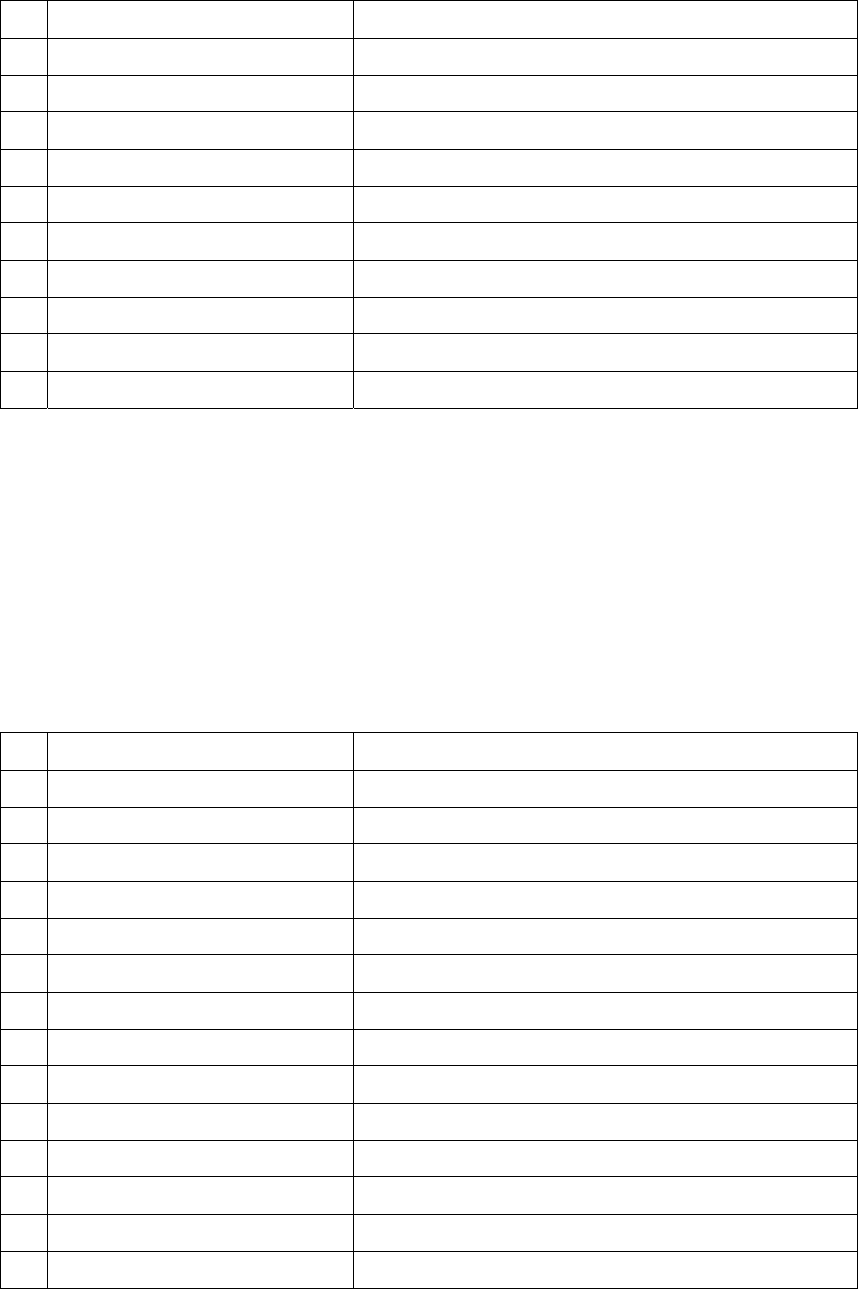
4 Ribbon Load Button for replacing or repositioning ribbon cartridge
5 Mobile Connector Socket for mobile chip
6 Power Button Power on and off (Option)
7 Card Output Stacker Stacker for released output cards
8 Printer Lid Open for replacing ribbons and cleaning rollers
9 Flipper Used for Dual sided printing (Option)
10 USB Socket Used for memory stick or USB connecting
11 USB Communication Port Used for connecting PC and printer with USB cable
12 RS232C Communication Port Used for connecting PC and printer with RS232C
13 Power Socket Used for supplying power
14 External RF Recognize RF Card
Page 9
TP-9000 (Auto Continuous Printing)
Front Rear
Side
Features Description
No Features Description
1 LED Display LED shows the status of printer
2 LCD Display LCD panel displays the status of printer
3 Card Eject Button for discharging card inside the printer
4 Ribbon Load Button for replacing or relocating ribbon cartridge
5 Mobile Connector Socket for mobile chip
6 Power Button Power on and off (Option)
7 Card Output Stacker Stacker for released output cards
8 Printer Lid Open for replacing ribbons and cleaning rollers
9 Flipper Used for Dual sided printing (Option)
10 USB Socket Used for memory stick or USB connecting
11 USB Communication Port Used for connecting PC and printer with USB cable
12 RS232C Communication Port Used for connecting PC and printer with RS232C
13 Power Socket Used for supplying power
14 External RF Recognize RF Card
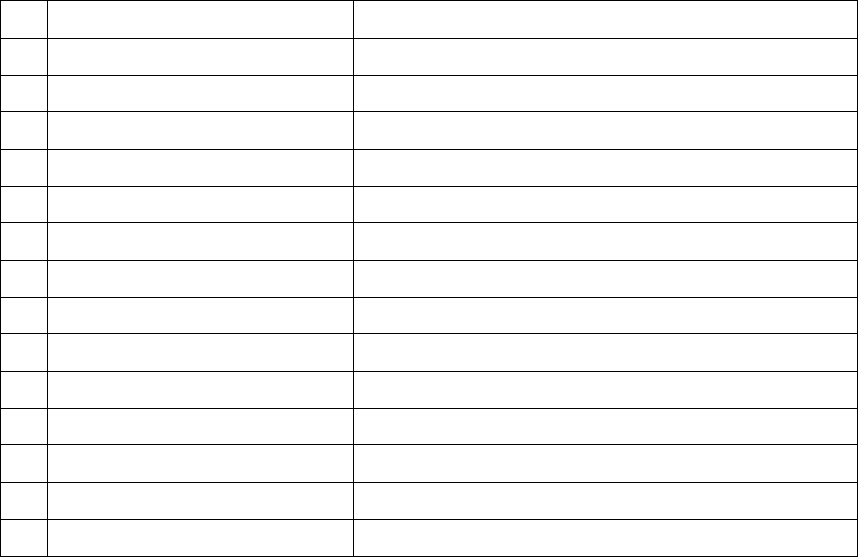
* Even though we have three different models of TP series, since there is no big difference
in operation, user’s manual has been designed for TP-9000 Dual Sided as main
reference.
Page 10
TP-9000 (Dual Sided, Auto Continuous Printing)
Front Rear
Side
Features Description
No Features Description
1 LED Display LED shows the status of printer
2 LCD Display LCD panel displays the status of printer
3 Card Eject Button for discharging card inside the printer
4 Ribbon Load Button for replacing or relocating ribbon cartridge
5 Mobile Connector Socket for mobile chip
6 Power Button Power on and off (Option)
7 Card Output Stacker Stacker for released output cards
8 Printer Lid Open for replacing ribbons and cleaning rollers
9 Flipper Used for Dual sided printing (Option)
10 USB Socket Used for memory stick or USB connecting
11 USB Communication Port Used for connecting PC and printer with USB cable
12 RS232C Communication Port Used for connecting PC and printer with RS232C
13 Power Socket Used for supplying power
14 External RF Recognize RF Card
* Even though we have three different models of TP series, since there is no big difference
in operating them, user manual is designed for TP-9000 Dual Sided as main reference.
Page 11
1.4 Loading Ribbon Cartridge
1. Unpack ribbon carton box.
2. Open printer lid by pressing Cover Release Button and raise it fully.
3. Make sure that ribbon cartridge is placed in right position and the printer lid is closed.
Note : Please note that improper closing lock of the printer lid may cause bad printing. (Check
out lock of the printer lid)
Page 12
1.5 Loading Cleaning Rollers
1. Open printer lid by pressing Cover Release Button and raise it fully.
U-shaped Slot
2. Slide the cleaning roller into the loading part and insert roller bar into U-shaped slots until it
locks in place.
Cleaning Roller
Page 13
1.6 Card Feeding Hopper
1. Open card the feeding lid.
Card thickness adjustment controller
2. Rotate card thickness adjustment controller in the card feeder to synchronize it with the card
you wish to print.
Card feeding weight
Card feeding weight
3. Lift the card feeding weight.
4. After stacking card into the card feeding hopper, put the weight on the stack of the cards.
Page 14
1.7 Card Output Stacker
1. Lock the latch of card output stacker into slots of the front side.
1.8 Power Device, Power cable, Communication Cable
PC, Communication cable, Power adaptor, Power cable

Page 15
2. Software Installation
PC Systems requirement
* Check out minimal PC operating environment.
* MS Widows: Windows 2000/XP (32bit), Windows Vista
* Computer
- CPU : Pentium Ⅲ 1GHz above (Pentium Ⅳ1.5 GHz recommended)
- Memory 128 MB above (512 MB recommended)
- HDD 1 GB above (5 GB recommended)
- Internet Explorer 5.5 above (6.0 recommended)
Note: For windows 2000/XP users, only administrator with authority can install and
remove the program after log-on.
Page 16
2.1 Installing FTD2xx Direct USB Driver
Installing
Close all windows in operation. (Recommended).
(Explanation is based on windows XP. Picture and sequence can differ in Windows
2000.)
1. Attach USB cable to computer and place the printer’s power switch in the ON position.
The [New Hardware installation] window will open. Select “Install from a list or specific
location”, then click “Next>”.
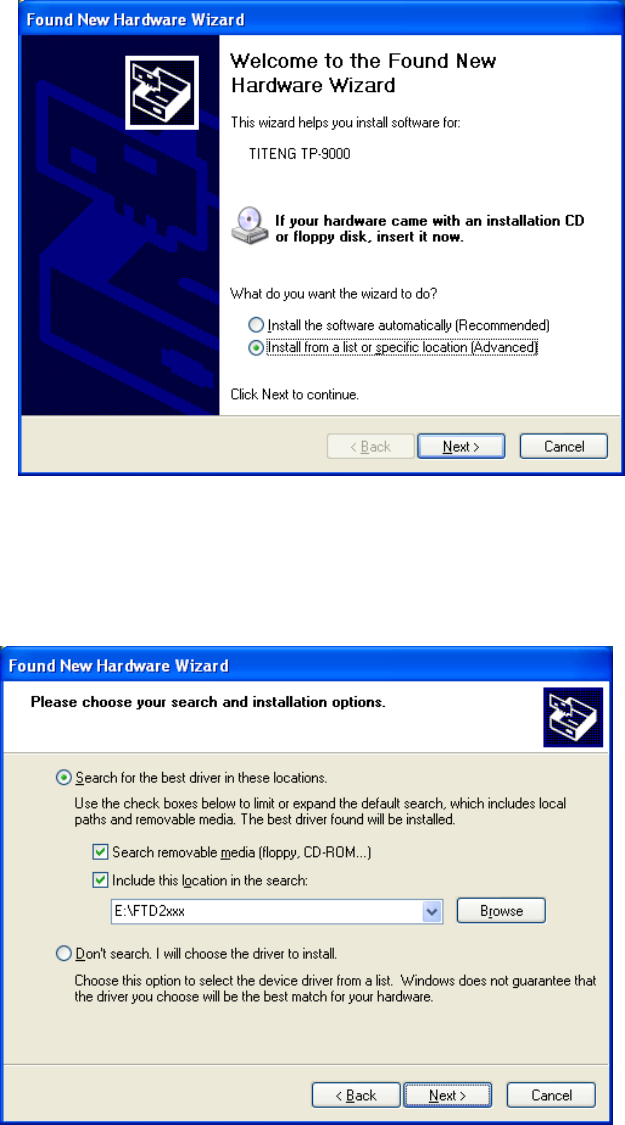
<New Hardware installation>
2. Select “Search for the best driver in these locations“ and “Include this location in
the search”. Click “Browse” to search the CD location as follows.
<Driver location and file searching>
Page 17
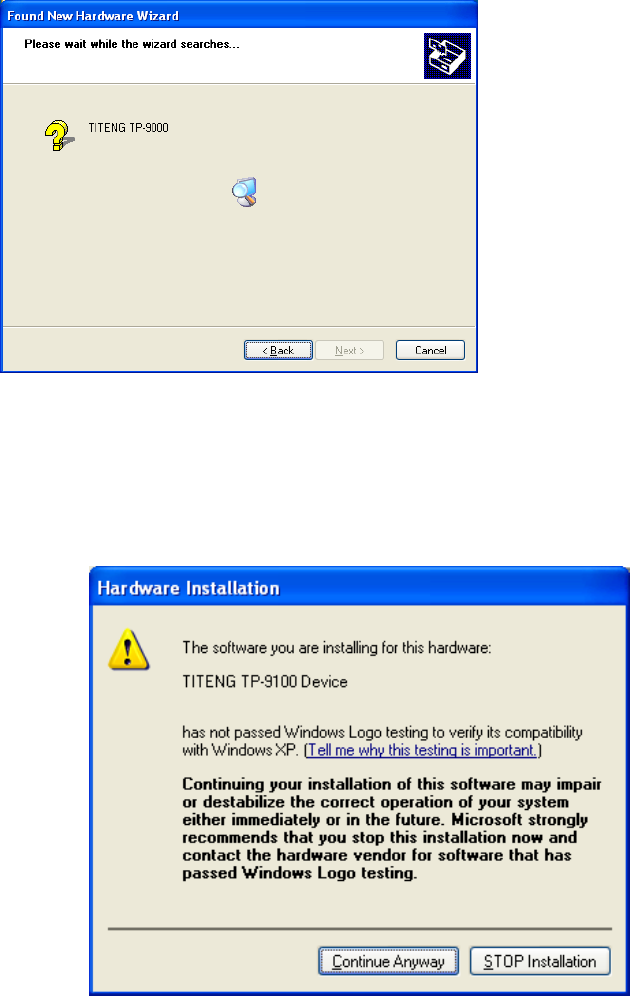
3. If FTD2xx driver has been found successfully, installation begins.
<Driver installing>
Page 18
4. In the “Windows Logo Testing” window, select the “Continue Anyway” button.
<Windows logo testing>
5. Click the “Finish” button and drive installation will be complete.
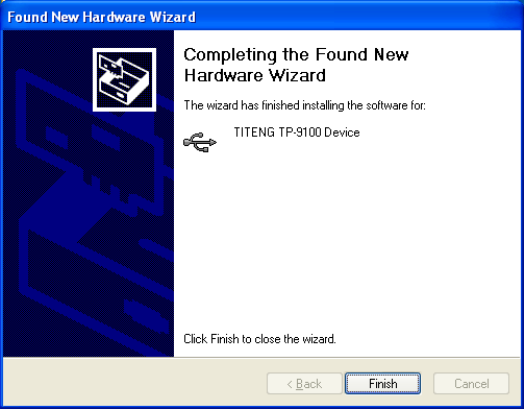
<Competing the Found New Hardware>
6. If Windows Restart message opens, restart windows.
Page 19
2.2 Installing Microsoft Windows Application Software / Driver
Installing
Close all windows in operation. (Recommended).
1. Turn on the computer. In the Found New hardware window, click “Cancel” button.
2. The “Insert installation CD” window will open automatically.
∙ Insert installation CD with printed side up in CD-ROM drive.
∙ If installation window does not open or if you have closed it, eject CD and re-insert.
In the “Start” Menu, select “Execute” and start ‘X(Number of CD-ROM drive):\install.exe’
and click “OK” button.
3. Automatically open software installation wizard window when you insert software CD.
Click “Start” to start installation process.
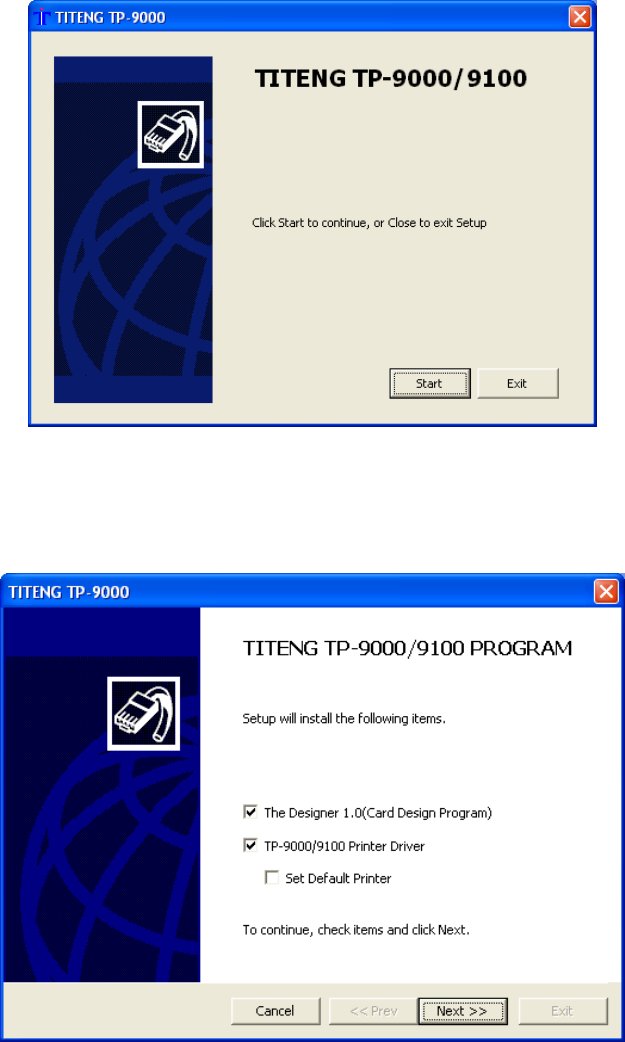
<Start window for software installation>
Page 20
4. Select the software you wish to install. Click “Next>>”.
<Software selection window>
5. Read License Agreement. Click “Approval” and “Next>>”.
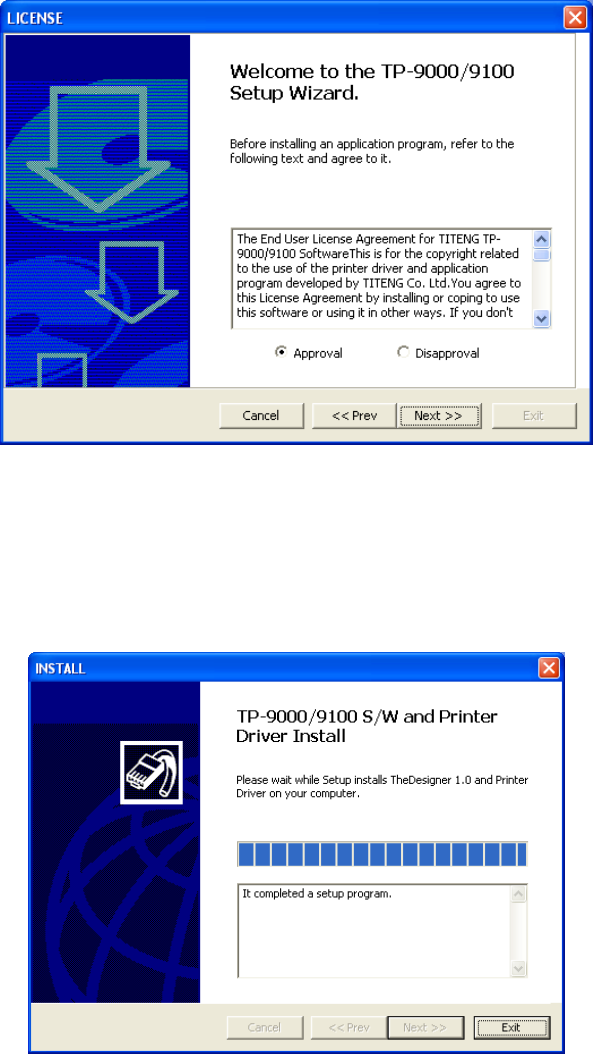
<Software license agreement>
Page 21
6. When installation is complete, Click “Finish“.
<Completing software installation>
7. Check out the “TITENG TP-9000” installed in the printer folder. Check out “TIT ENG
TP-9000” software installed in “START -> ALL PROGRAM” -> “TITENG TP-9000”.
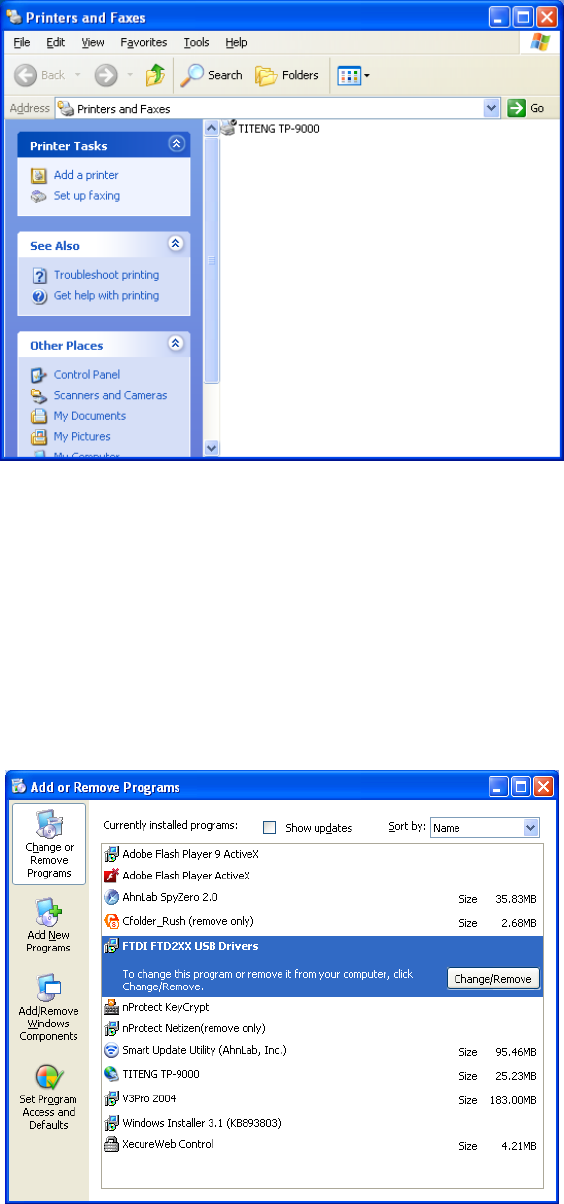
<Printer driver folder>
Page 22
2.3 Removing FTD2xx Direct USB Driver
1. Execute “Start -> Control Panel -> Change or Remove Programs”.
2. Click “Change/Remove“ to start the process.
<Removing FTDI FTD2xx USD Drivers>
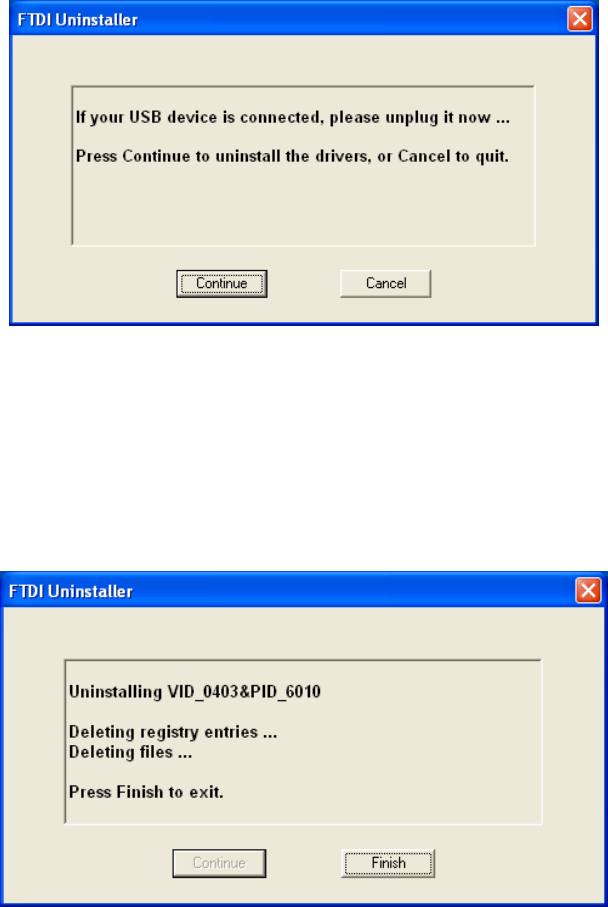
3. Click “Continue” to remove USB driver.
<Uninstalling>
Page 23
4. When uninstalling is complete, finish the process to click “Finish”.
<Completing Uninstalling>
2.4 Removing TP-9000 Application Software / Driver
1. In “Start” -> “All Program” -> “TIT ENG TP-9000” -> Click “Remove” to start the process.
* Note: When you remove “TITENG TP-9000”, TITENG TP-9000 printer driver is removed
at the same time.
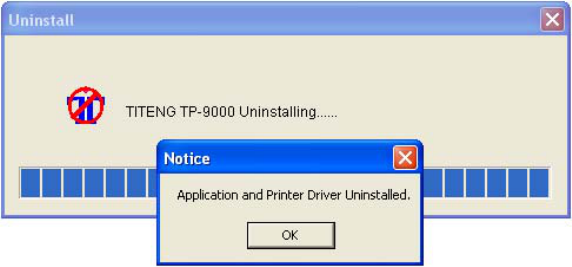
<Uninstalling Completed>
Page 24
2.5 Printing with TP-9000 on Microsoft Windows Application Software
* This section gives you instructions on how to print on Windows application software.
· Print sequence may differ according to application software. To ensure right sequence,
please refer to user manual of the application software.
1. Open file of the Windows application software you wish to print.
2. Go to “File” => “Print”.
∙ Make sure that you choose TITENG TP-9000.
∙ Print sequence may differ according to application software. On most of windows
application software, you can print out by clicking printer icon on menu bar or print in “File”
menu.
3. Select documents you wish to print. Click “Print” or “OK” to start printing process. The
files to be printed standing by in spool allocated for TP-9000.
· Ensure that the printing image is oriented in same direction (vertical, horizontal) as that
of paper. Preview function of software will help you check it out.
* What is TITENG TP-9000 Spool?
Spool saves data temporarily on hard disk from application program, not sending more than
one job to printer at a time. And the system will hold them up until the printer can accept the
data.
Page 25
Canceling Print
* There are two ways to cancel printing. Canceling in application software and canceling in
spool in a queue.
· If card is jammed on the way of printing, you have to cancel it, which costs ribbon and card.
Canceling in Spool
* Spooled files queue up for being sent to printer.
1. Double click printer icon in menu bar in bottom right.
2. If user wishes to change settings, right click on the printer icon.
· Information: Shows the information of spool
· Hide after printing: If printing is complete, spool window disappears.
· Always on top : Set the spool window always on top.
· EXIT: Terminate spool window.
* Spool program resume when printing in operating again, even though you have already
terminated it.
3. Set up all spooled file prior to printing.
· Right click on the printing standby.
You can select one of “All document stop“, “All document start“ and “All document cancel“.
Page 26
4. Set up of spooled file in printing
· Click right button on spooled file in printing. You can select one of “Stop“, “Resume“,
“Cancel“.
Caution
If you stop the document printing, the file in printing can be mixed up with other spooled file.
Controlling TIT ENG TP-9000 printer remote
* Program that allows users to control TITENG TP-9000 remote is provided. Follow procedure
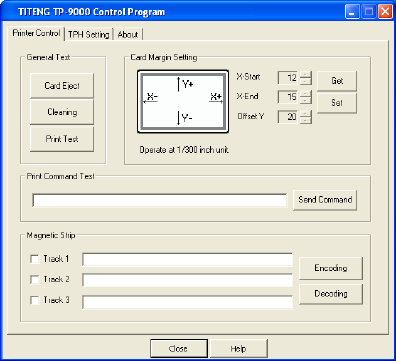
below to set up status of printer for remote controlling.
1. Click “Start” -> “All Programs” -> “TITENG TP-9000” -> “TITENG TP-9000 remote
controlling program”
· Printer control tab
Printer cleaning function is provided for best printing quality. If image of printed card is
incorrectly positioned, set the card margin.
Page 27
· Printer head set up
Set color density for best printing quality. And input TPH resistance value.
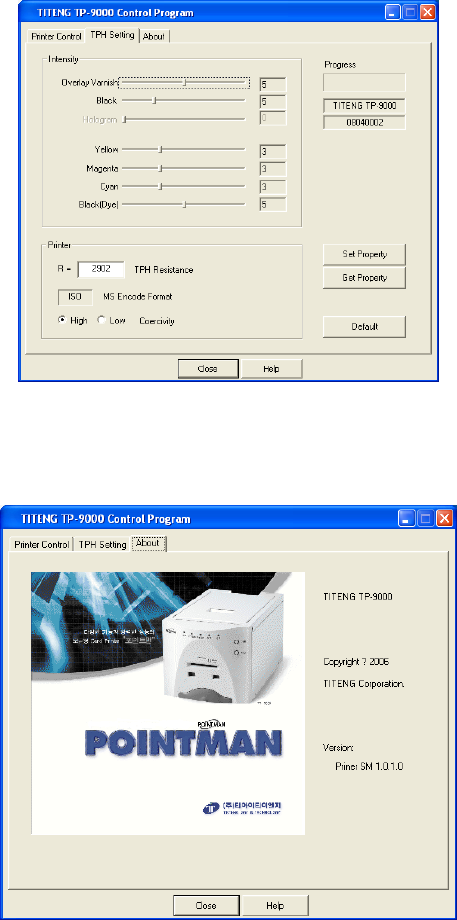
· Printer information tab
In the printer information tab, copyright and version is described.
Page 28
2.6 Printer Settings in Microsoft Windows
* User can set up own printing environment with various functions the printer provides.
Opening Printing Preferences window of the printer
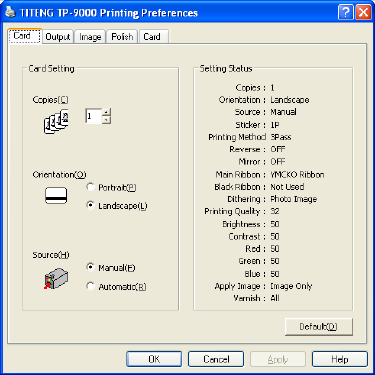
* The values input in printing program will get back to previous one when current operating
program terminates.
Opening Printing preferences on application software
1. Execute printing order in application program.
2. Click <Printing Preferences>.
3. Click each tab and windows will open.
4. Upon completing settings, click <OK>.
Opening in printer folder
1. “Start” -> “Printers and Faxes”
2. Double click “TITENG TP-9000”
Page 29
3. Open Printing Preferences window in a printing queue as follows “Printer” -> “Printing
Preferences“ -> “Properties” -> “Printer Setting”
4. Click each tab, then window opens.
2.7 Printer Driver Settings
Registered information of the printer
· “Card” tab
Set the number of copies, the card orientation, manual/auto feeding.
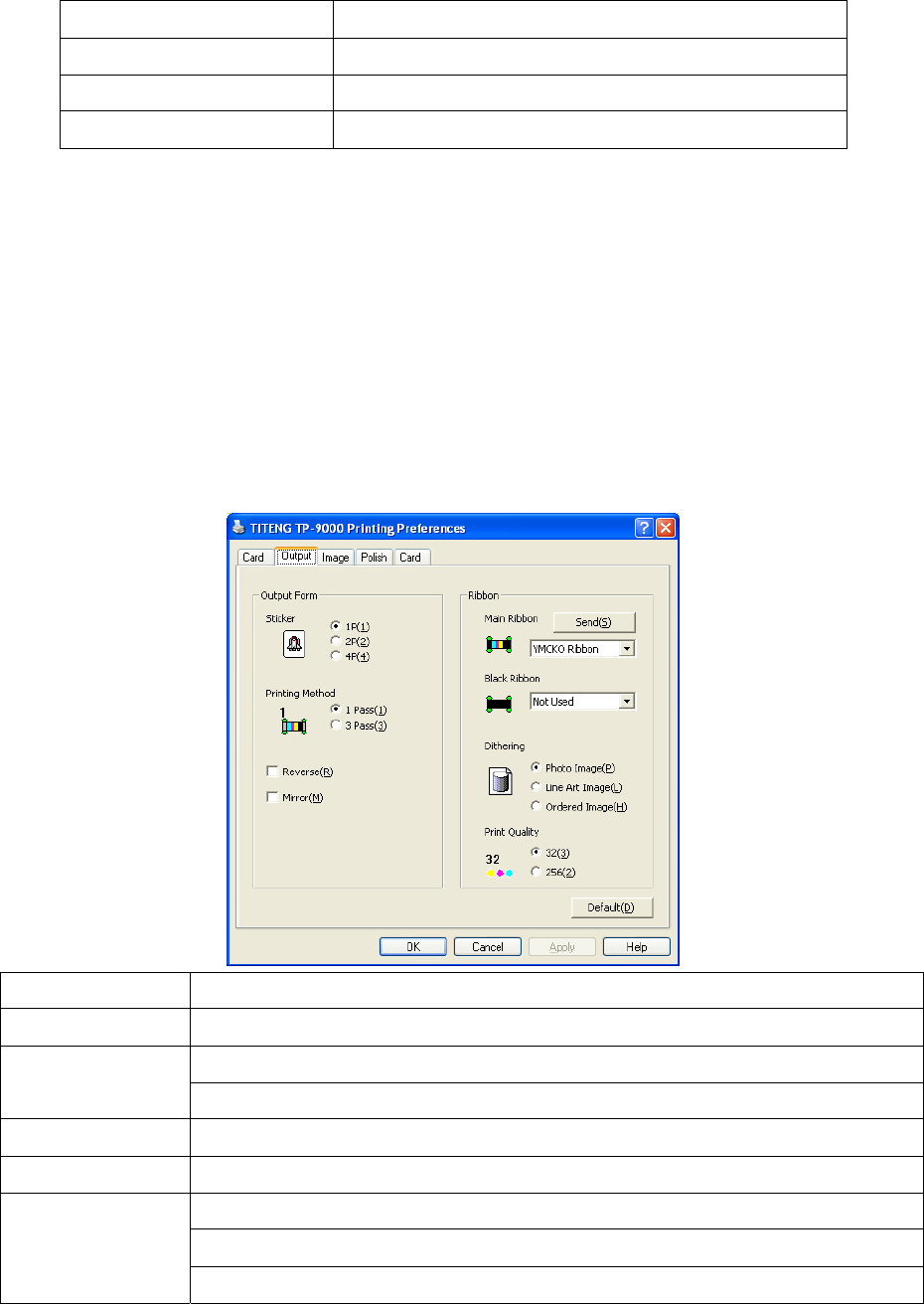
Items Descriptions
Number of copies Set the number of copies; 1 to 999
Card orientation Set the card orientation. Default is horizontal.
Manual / Auto Feeding Set the card feeding method; manual or auto
* NOTE: Ensure that the printing image is oriented in same direction (vertical, horizontal) as
that of card. Preview function of software will help you check it out.
Page 30
· “Output” tab
Set Sticker, Printing Method, Main Ribbon, Dithering.
Items Descriptions
Sticker Print same image in sticker format for 1, 2, 4 sheets.
Printing Method 1 pass print: Transfer all data of YMCKO and then print.
3 pass print: Transfer corresponding data of each color and then print.
Reverse Reverse RGB and print.
Mirror Mirror the printing data and print.
Main Ribbon
YMCKO Ribbon: Yellow, Magenta, Cyan, Black, Overlay
K Resin: Resin black ribbon. Capable to print 256 color level.
K Wax Resin: Wax resin ribbon
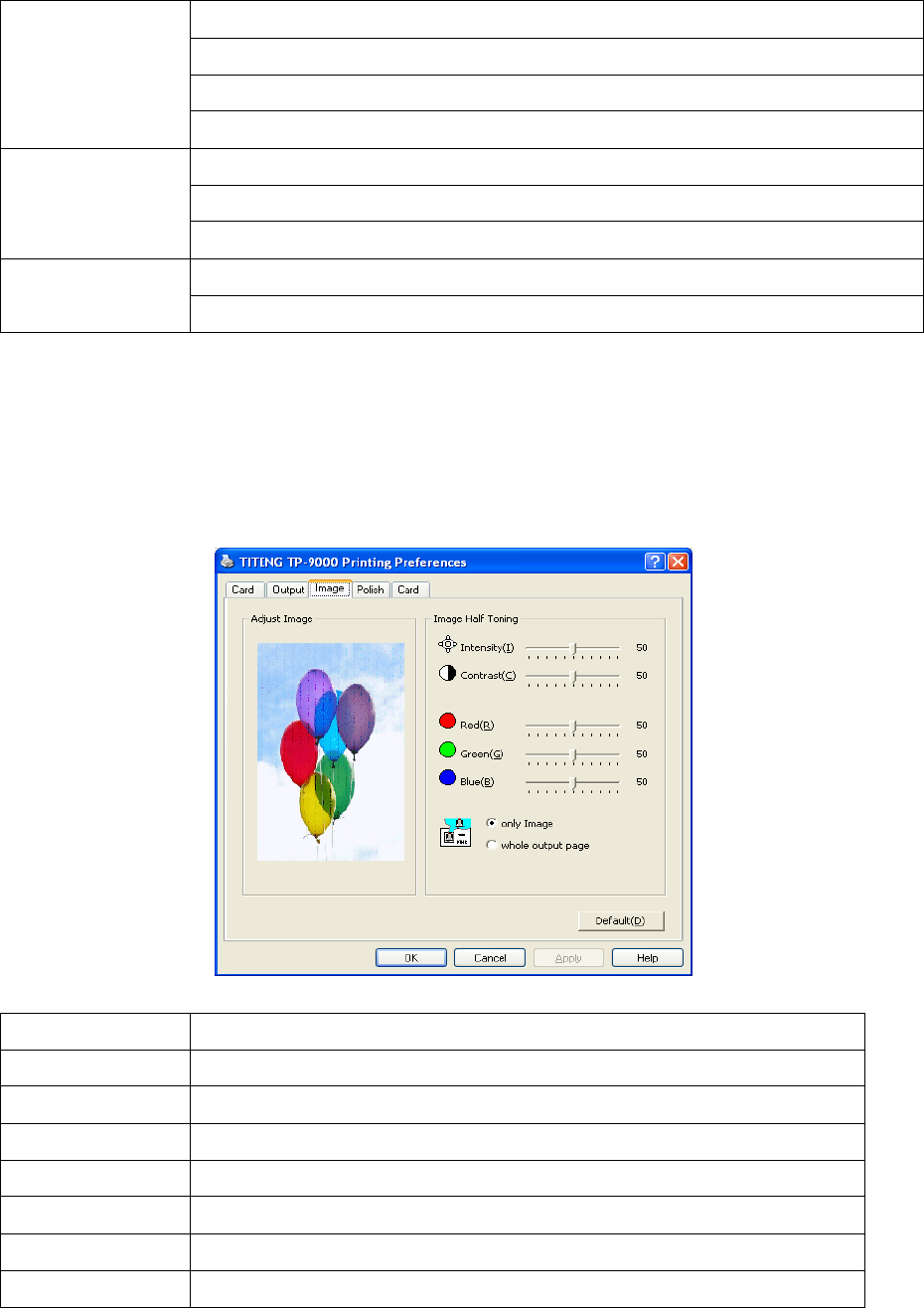
Black Ribbon
Not used: Black printed in color
Text: Print text in document with K ribbon.
Always: Print all black in document with K ribbon.
Except image: Print all except image in document with K ribbon
Dithering
Photo image: Print soft image
Line Art Image: Print image in pattern set.
Ordered Image: Print image in ordered pattern
Print Quality 32: Print image level 32 (fast printing)
256: Print image level 256 (High quality printing)
Page 31
· “Image” Tab
Set the Card Orientation, Printing Quality, Paper Size and Paper Quality
Items Descriptions
Intensity Set brightness of image
Contrast Set contrast of image and make it more bright
Red Set red
Green Set green
Blue Set blue
Only Image Half toning applicable only to image
Whole print page Half toning applicable whole data
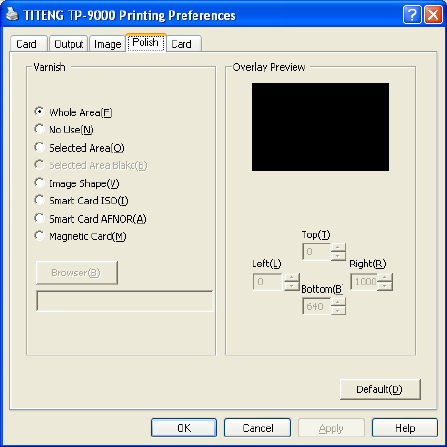
Page 32
· “Polish” Tab
Set varnish on the card.
· “Card” Tab
If you click the image, the website of TIT ENG Co., Ltd. will open on internet browser.
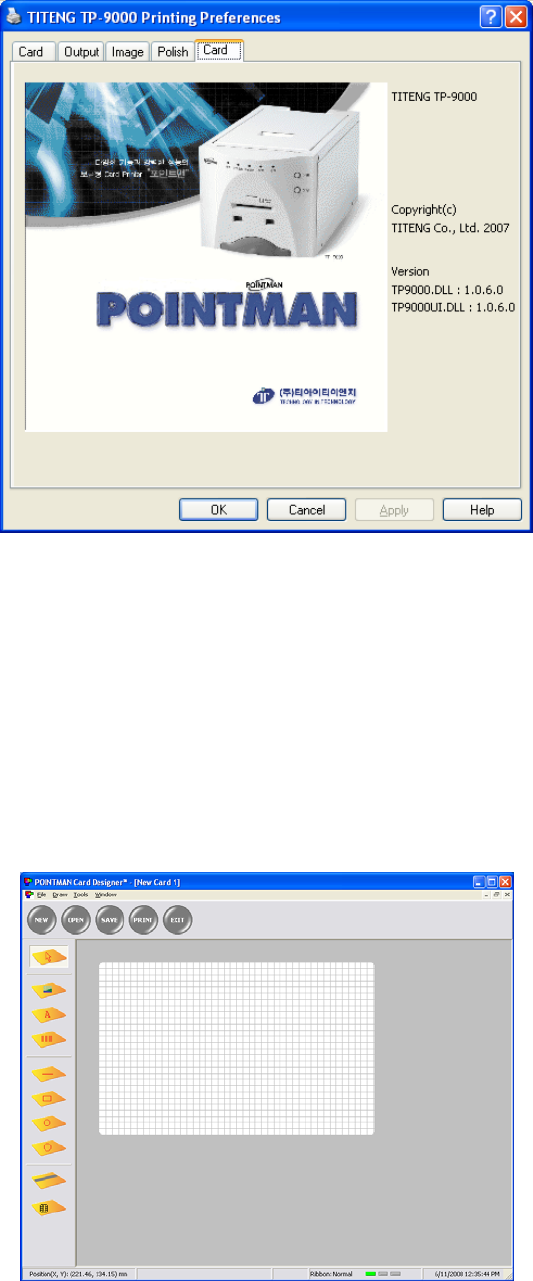
Page 33
3. Printer Operation
3.1 Getting Started
The Designer 1.0 is software that allows user to design and issue cards. Follow the steps below
to create cards.
Select “Start” -> “All Program” -> “TIT ENG TP-9000” -> “The Designer”
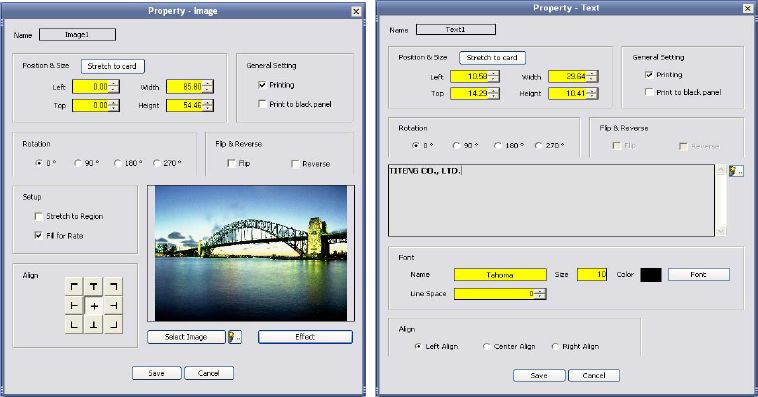
3.2 Description on Features
· NEW : Design new card. Up to 10 windows can be created at the same time.
· OPEN: Read a saved card design
· SAVE: Save a card design
· ISSUE: Print a card
· EXIT: Terminate the window
Page 34
3.3 Designing Card
IMAGE designing
1. Select (이미지) icon to start image designing in The Designer.
2. Drag mouse on the range where image is positioned on card.
3. When window of “Properties – Image” opens, click “Select Image” button. Select
image you wish to insert.
4. Click “Save”, then the selected image is inserted.
5. You can change properties of the inserted image.
TEXT designing
1. Select (이미지) icon to start text designing in The Designer.
2. Drag mouse on the range where text is positioned on card.
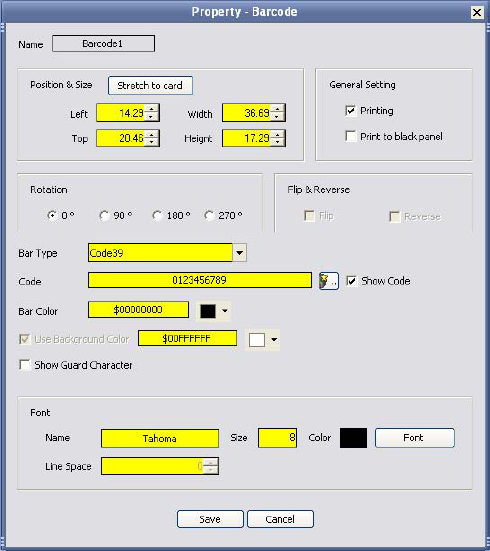
3. When window of “Properties – Text” opens, type the text you wish to insert.
4. Click “Save”, then the text is inserted.
5. If you wish to change properties of the inserted text, double click on the text.
Page 35
BARCODE designing
1. Select (이미지)icon to start bar code designing in The Designer.
2. Drag mouse on the range where barcode is positioned on card.
3. When window of “Properties – barcode” opens, insert “Code” you wish to insert.
4. Click “Save”, then the bar code is inserted.
5. If you wish to change properties of the inserted text, double click on the bar code.
DIAGRAM designing
1. Select (이미지)icon to start diagram designing in The Designer.
2. You can draw Diagram; Circle, Rectangle, Oval.
3. If you wish to change properties of the diagram, double click on the diagram.
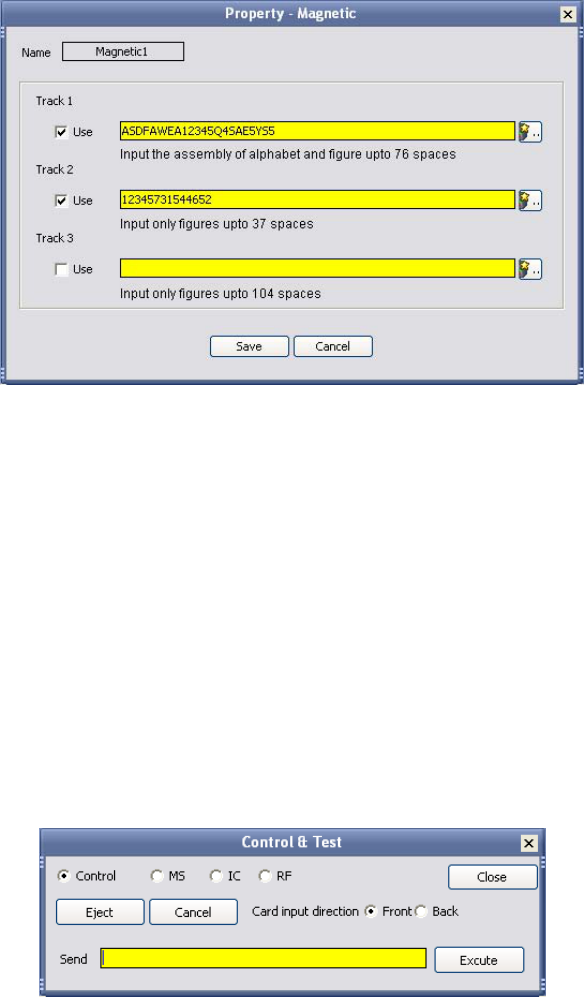
Page 36
MAGNETIC CARD
1. Select (이미지)icon to start diagram designing in The Designer.
2. Magnetic stripe is displayed within the range of card.
3. If you wish to input data into magnetic stripe, double click the magnetic stripe and input
data in the relevant track.
IC CARD
1. Select (이미지)icon to start image job left of the ISSUE window.
2. IC chip is displayed within the range of card.
Page 37
3.4 Tools
Device Control
User can control printer remote. After input of printer control code described in the manual, click
“Execute”.
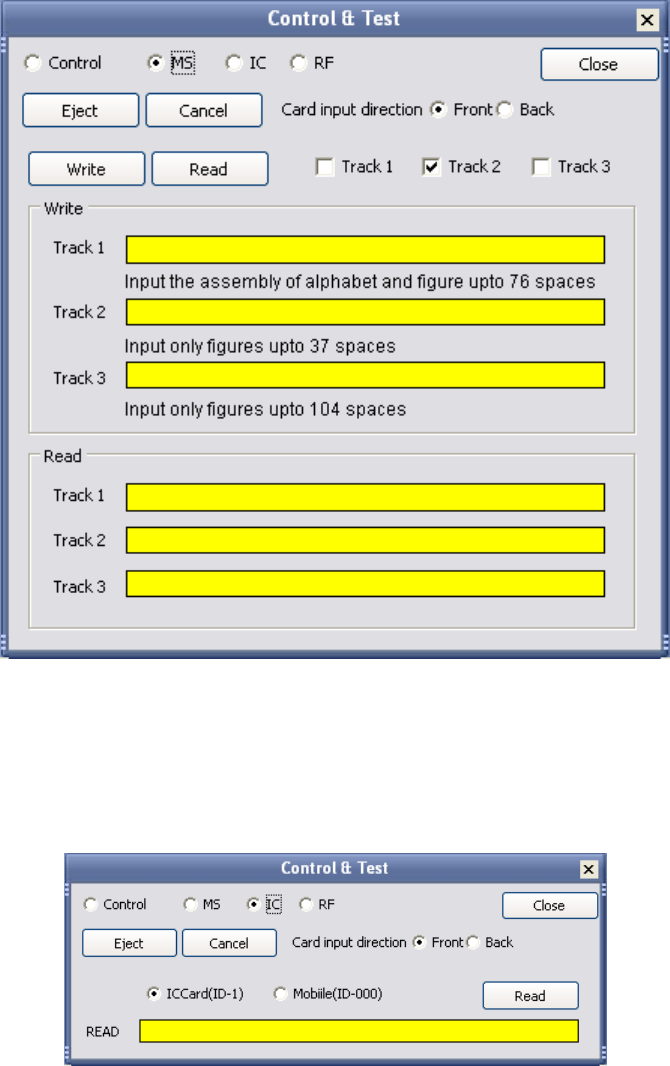
Magnetic card
After input of data to be written on magnetic track, click “Write”. Click “Read” to read the saved
data on each track.
Page 38
IC CARD
Select “IC” and click “Read” button. Progress bar will show communication status with IC chip.
IC CARD
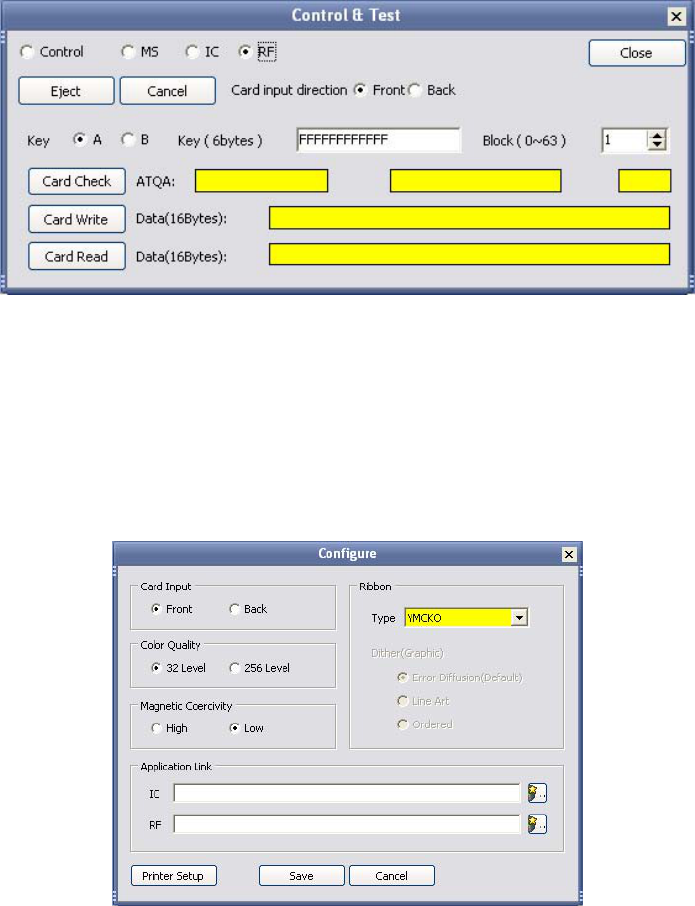
Click “Card Read”. The progress will show communication status with RF card.
Page 39
3.5 Configuration
Configure
When issuing card, user can set the type of ribbons, the card orientation and dithering for black
ribbon. When issuing IC card or RF card, user can set the external program necessary.
Page 40
3.6 Data Synchronizing
* Data Synchronizing will help user to synchronize data created in Microsoft Excel or Microsoft
Access with what will be used in card issuing software for card creation. User can make card
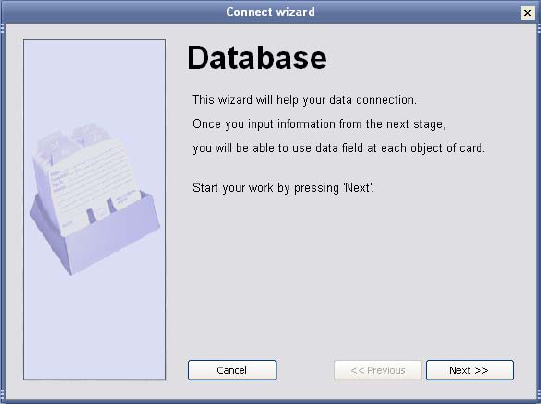
effectively in shorter time.
EXAMPLE
If user would like to issue company staff’s card, user would have staff list database. If there is no
database, user is recommended to make up a list in Microsoft Excel as follows.
* If you have data file and picture file in the same folder, you can synchronize them only with file
name and extention. (example: James.jpg)
Page 41
Data Connect Wizard
1. The Designer “Tool” -> “Data Connect“ -> “Data Connect wizard”
2. Select target database to synchronize. (Select Excel Work Sheet if target DB is in Excel
format)
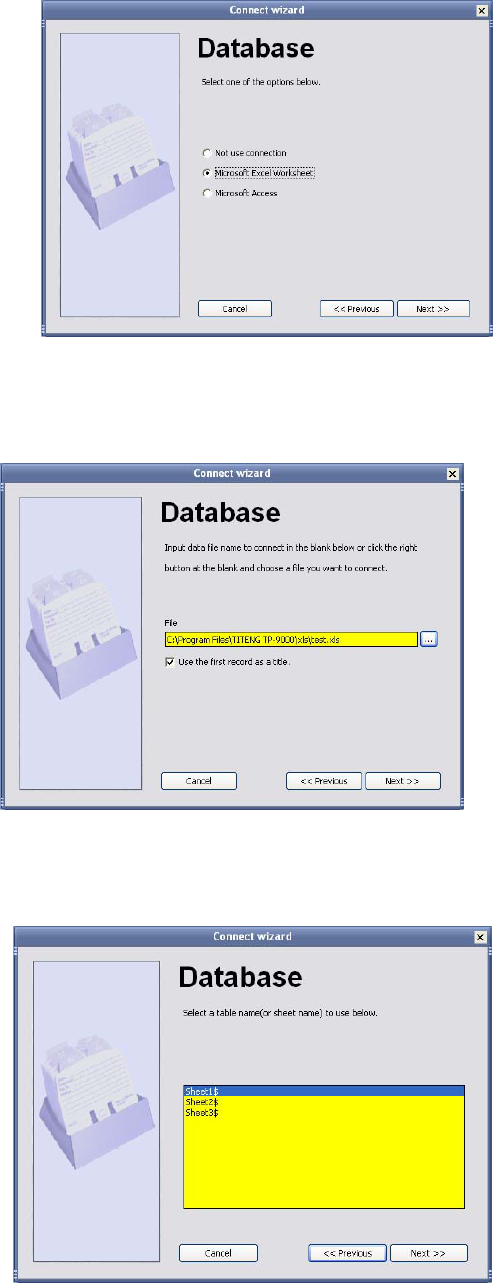
3. Choose database file.
Click “Use the first record as a title“. The first record will not be used.
Page 42
4. Select sheet in the selected database.
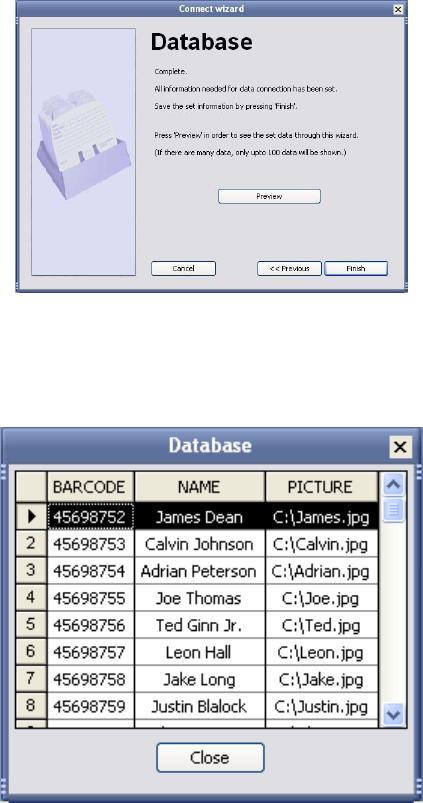
<Choose Microsoft Excel Worksheet 1>
5. Choose Sheet to be used in database.
<Completing synchronizing>
p
6. If synchronizing with target database is complete, click “Preview”.
Page 43
Synchronizing data on the card with database (ex. Staff number)
1. Double click Barcode (Field 1) on database to synchronize.
<이미지 그대도 사용> Field1 Double click
2. Click “Data input” button. Select “Data field” for data input. Select “Staff number” for
data field. Click “+” to add data for staff number. Click “Finish”.
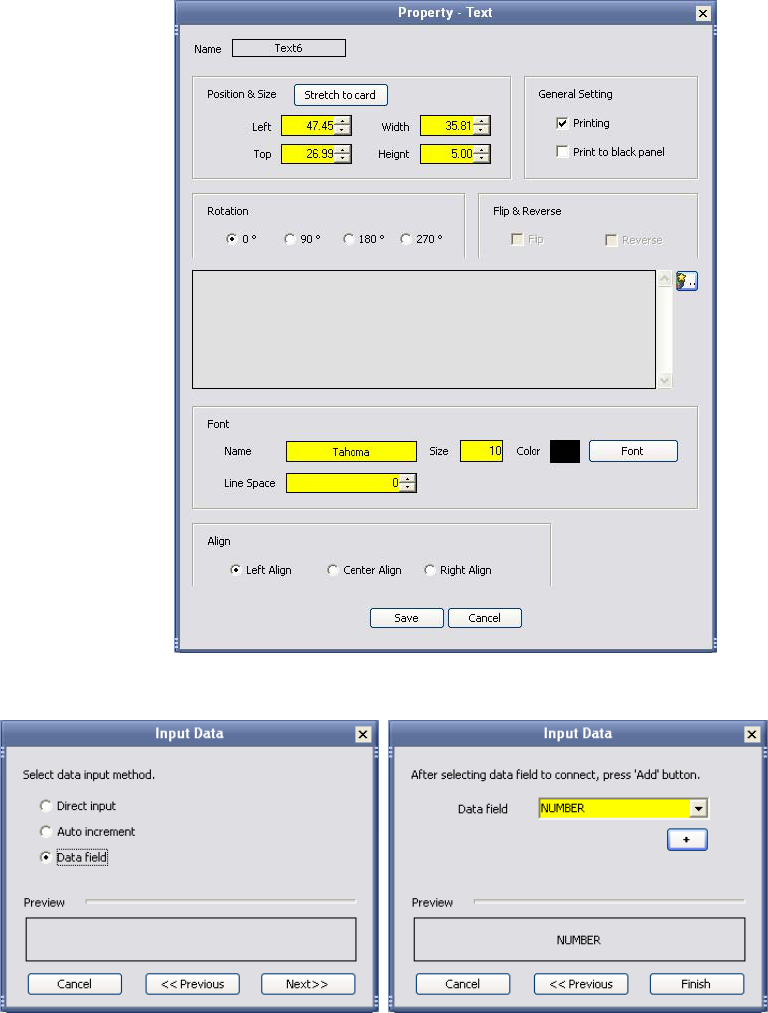
Data input button
Page 44
Synchronizing data on the card with database (ex. Staff name)
1. Double click “Staff Name” (Field 2) on card data to synchronize.
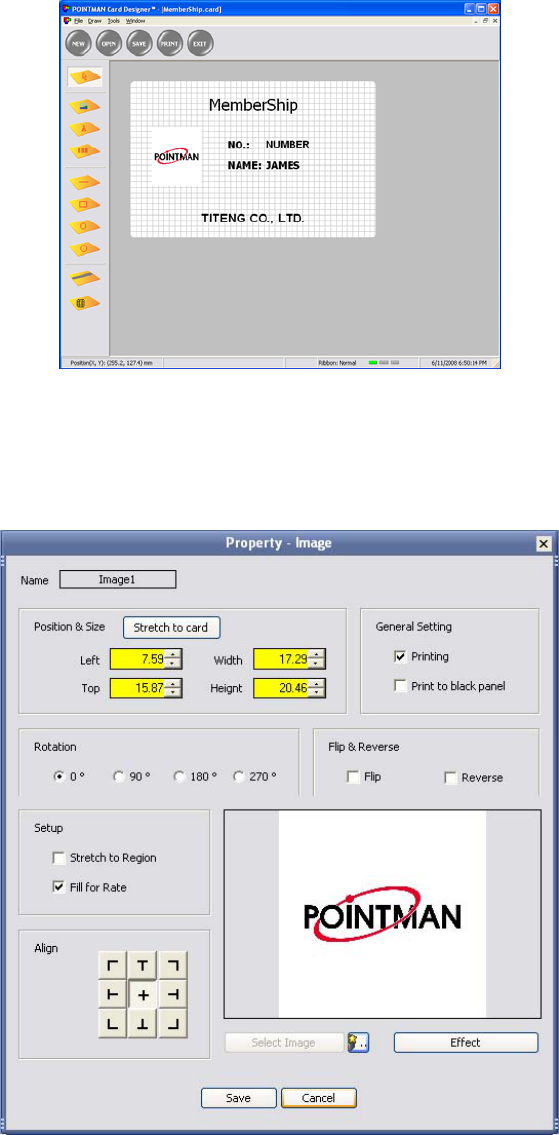
Field3 Double Click
2. Click “Data input” button. Select “Data field” for data input. Select “Staff Name” for
data field. Click “+” to add data for staff number. Click “Finish”. And Click “Save”.
Page 45
Synchronizing data on the card with database (ex. Staff picture)
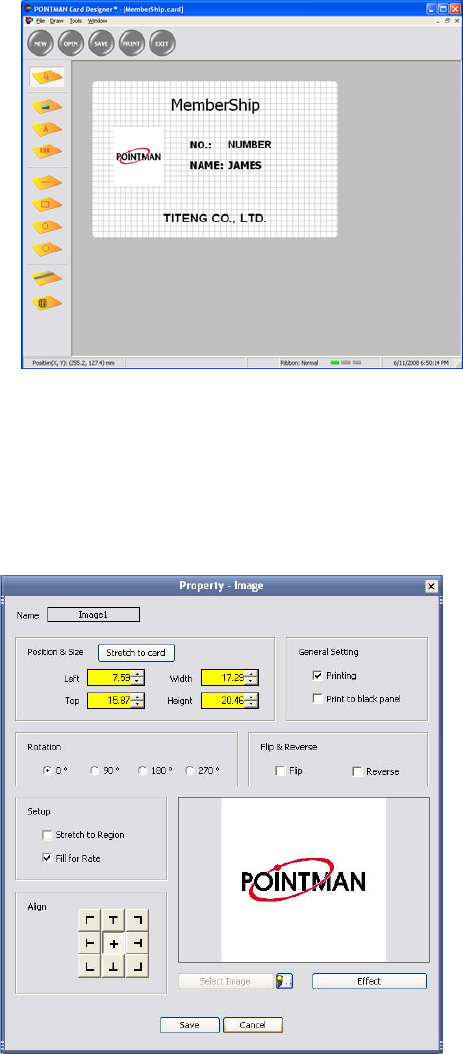
1. Double click “Staff Name” (Field 3) on card data to synchronize.
Field3 Double Click
2. Click “Data Input” button. Select “Data Field” for data input. Select “Staff Picture” for
data field. Click “+” to add data for staff number. Click “Finish”. And Click “Save”.
Data input button
Page 46
3.7 Card Printing
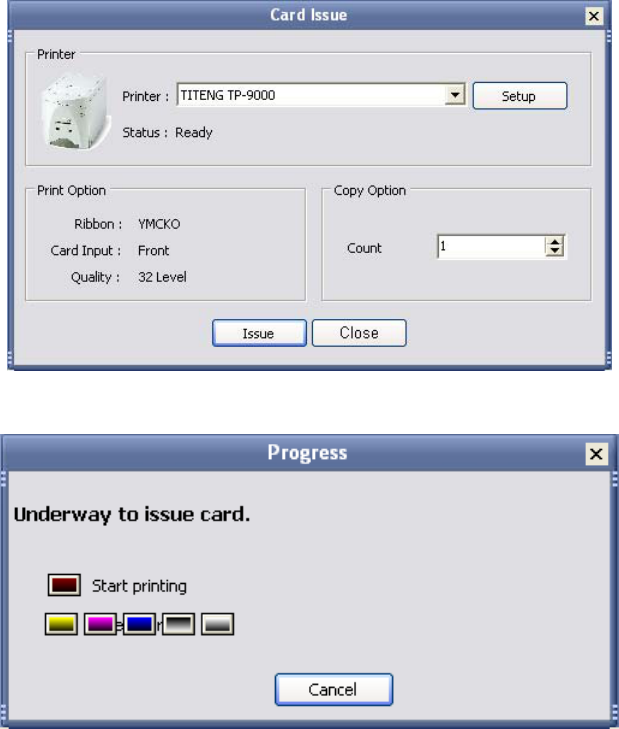
Card Issue
If you click “Issue” on The Designer, window below will open.
Click the “Issue” button, then progress bar window will open and printing starts.
Page 47
4. Instructions on Maintenance
4.1 Maintenance of Product
Never use card below
· Heavy damaged card
· Card with heavy dirt
· Card with scratch
· Bended or deformed card
Cleaning
· Place the printer power switch in the OFF position and pull out the plug and power adaptor.
Cleanse the surface of the printer with wet soft cloth.
· Do not let water inside the printer.
· When the printer gets dry, turn power on.
Page 48
4.2 How to Replace Ribbon Cartridge
1. Open printer lid by pressing the Cover Release button.
2. Hold the used ribbon cartridge and pull it out from the printer.
3. Make sure that supply ribbon and rewinding ribbon placed in right position. Close the
printer lid.
Page 49
4.3 How to Clean the Printer
Cleaning card
* Dirt or embedded contamination on roller may cause problem. Follow the recommended
maintenance procedures below.
1. Turn the power off and remove card and ribbon cartridge.
2. Turn the power on with pressing “Eject” button at the same time. When front LED panel
flashes, insert the cleaning card wet with alcohol cleanser into the front card slot.
3. After completing cleaning, cleaning card is ejected automatically. And the cleaning card is
reusable.
4. Leave the printer for 2 ~ 3 minutes until alcohol cleanser evaporates.
Cleaning Roller
* For cleaning roller maintenance, follow the procedures below.
1. Remove the cleaning roller from the printer.
2. Wet and clean the cleaning roller in flowing water.
3. When the cleaning roller gets dry, insert it into the printer.
Page 50
4.4 How to Replace TPH(Thermal Print Head) and Consumables
1. Turn the power off. Open printer lid by pressing the Cover Release button.
2. Pull the TPH upward and backward, then head cover is detached. And disconnect cable
connectors from the printer.
3. Connect the new TPH’s cable connectors to the printer.
4. After completing TPH replacement, execute “Start” -> “All Program” -> “TITENG TP-9000”
-> “Remote Control Program”.
In remote control program, set the resistant value of new TPH. Click the “Printer Transfer”
button.
* For more information, refer to “Printer Head settings” on page 26 in the user’s manual “.
* TPH resistance value is described on TPH.
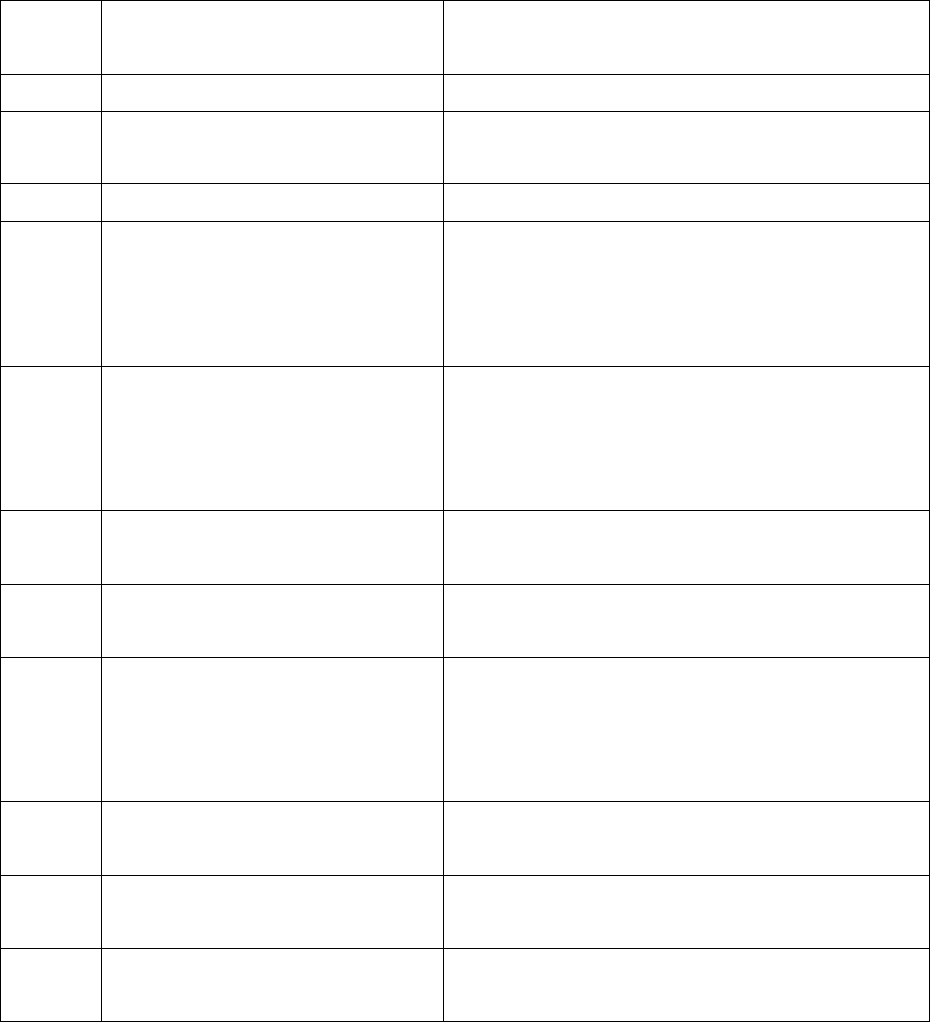
Page 51
4.5 Trouble-shooting
1. In case front LED keeps on flashing or always on all the time.
Error
Code Trouble Solution
10 TPH Module open - Check TPH module is closed
11 TPH Up/Down failure - With TPH module opened, check printer inside and
turn power off and on. Perform module Up/Down.
12 Card jammed Remove the jammed card inside the printer
13 TPH temperature trouble
- Check that temperature is within the operating
temperature range.
- Open TPH module and check that cable is
correctly connected.
14 Encoder trouble in ribbon control
part
- Check that ribbon is cut
- Check that ribbon run out.
- Check that encoder in ribbon control part is
correctly assembled and operates normal.
15 Medium trouble - Check that size of the medium meets specification
- If same trouble repeats, contact dealer.
16 EEPROM trouble - Turn power on again. If same trouble repeats,
contact dealer.
17 IC Contact Module not correctly
positioned
- Check that IC Contact Module is correctly
positioned
- If not correct, turn power off and on.
- If same trouble repeats, contact dealer.
50~51 Flipper module communication
trouble
- After remove card, turn power on.
- If same trouble repeats, contact dealer.
52~56 Flipper module mechanism trouble - After remove card, turn power on.
- If same trouble repeats, contact dealer.
57 Flipper improperly positioned or
Card inside - After remove card, turn power on.
* After the trouble above is resolved, perform one of three below to get printer into normal
operation.
1) Press reset button with ribbon cartridge correctly loaded.
2) Press “EJECT” button
3) Place power switch in OFF position, and ON position.
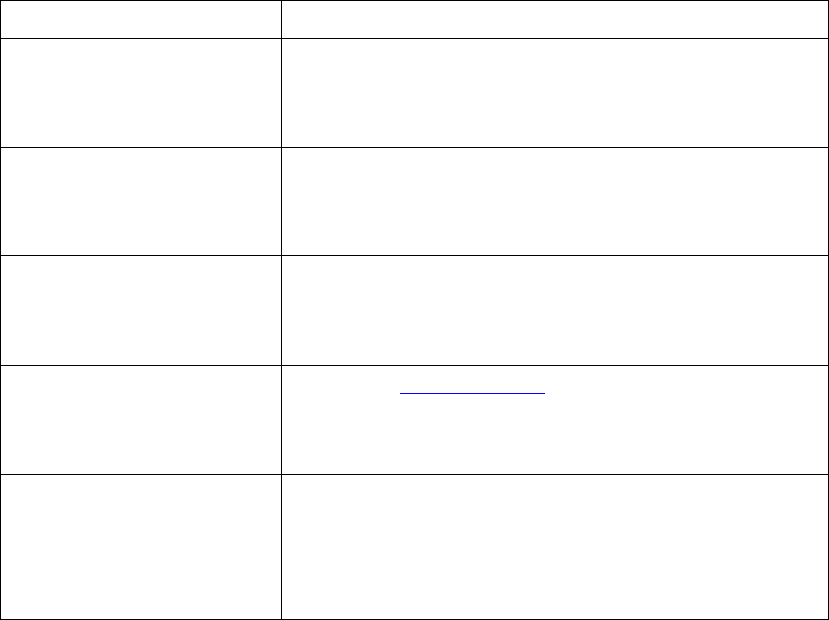
Page 52
2. Other troubles
Trouble Solution
Found frequently ribbons cut
in the front edge of card
when printing
- In printer driver or The Designer settings, increase Print
Start Position.
Found frequently ribbons cut
in the rear edge of card
when printing
- In printer driver or The Designer settings, increase Print
End Position.
Printer not found in The
Designer or application
software
- Check that printer driver is correctly installed.
- Check that communication cable is properly connected
- Reboot your PC.
Other than power LED, 4
Front LEDs continuously
flash in sequence
- Check out www.titeng.co.kr for firmware download.
- Download the latest version of firmware for the printer.
- Perform install using firmware install program.
Firmware installation not
performed
- With pressing “EJECT”, “RESET” switch at the same
time, place power switch in the ON position.
- Check that front 4 LEDs flash in sequence, install
firmware using firmware install program.
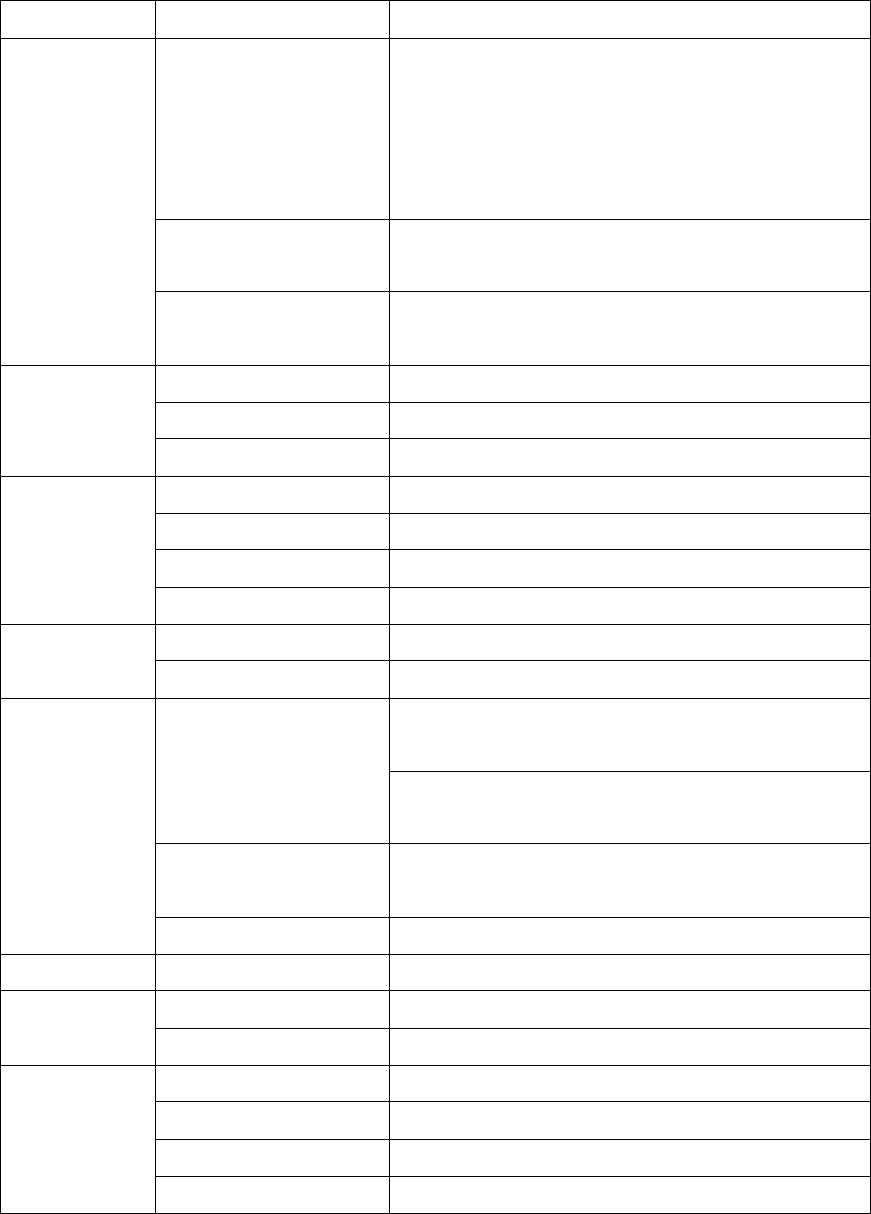
Page 53
4.6 Technical Specifications
Motor Motor Step Motor Driven
Print
Thermal Dye
Sublimation
1) Printing : Dye Sublimation
2) Printing Speed:
Mono 4 sec, Color single sided 25 sec, Color
dual-sided 20 sec(YMCKO)
3) Printing side: Single or Dual sided
TPH 1) Resolution : 300DPI(11.8DPM)
2) Pulse Life: 1x108 , Abrasion: 50km
Color & Mono 1) Color: 165K color, Full color
2) Mono: Black + Overlay, Black
Ribbons
Cartridges
Color (YMCKO) 200 cards / cartridge
Mono (KO) 500 cards / cartridge
Black (K) 1,000 cards / cartridge
Electrical
CPU 32 Bit Processor
RAM 64 Mb
User inferface LCD, LED, Switch
Power adaptor Input: 110 ~ 220 V / 50 ~ 60Hz, Output: 24 V / DC
Cards PVC Card 53.98(W) x 85.7(H) x 0.77(T)
PET Card 53.98(W) x 85.7(H) x 0.2(T)
Encoding
Magnetic Stripe
1) Single Track (Track2) (Default)
2) HiCo/LoCo
1) ISO7811 (Track1,2,3) (Option)
2) HiCo/LoCo
Contact (IC) 1) ISO7816 (Option)
2) EMV, K-Cash
Contactless (RF) ISO14443 A, B, Mifare
Interface USB USB1.1, USB2.0
Environmental Operating Temperature 0℃ ~ 35℃, 20 ~ 70% RH
Storage Temperature -25℃ ~ 70℃
Dimension
TP-9000 (Single Sided) 292(L) x 196(H) x 192(W)
TP-9000 (Dual Sided) 359(L) x 196(H) x 192(W)
TP-9100 (Single Sided) 403(L) x 202(H) x 192(W)
TP-9100 (Dual Sided) 471(L) x 202(H) x 192(W)
FCC (Federal Communications Commission)
This equipment has been tested and found to comply with the limits for a Class B digital device,
pursuant to Part 15 of the FCC Rules. These limits are designed to provide reasonable
protection against harmful interference in a residential installation.
This equipment generates uses and can radiate radio frequency energy and, if not installed and
used in accordance with the instructions, may cause harmful interference to radio
communications.
However, there is no guarantee that interference will not occur in a particular installation. If this
equipment does cause harmful interference to radio or television reception, which can be
determined by turning the equipment off and on, the user is encouraged to try to correct the
interference by one or more of the following measures:
- Reorient or relocate the receiving antenna.
- Increase the separation between the equipment and receiver.
- Connect the equipment into an outlet on a circuit different from that to which the receiver is
connected.
- Consult the dealer or an experienced radio/TV technical for help.
WARNING: This equipment may generate or use radio frequency energy. Changes or
modifications to this equipment may cause harmful interference unless the modifications are
expressly approved in the instruction manual. The user could lose the authority to operate this
equipment if an unauthorized change or modification is made.
This device complies with Part 15 of the FCC`s Rules. Operation is subject to the following two
Conditions:
1. This device may not cause harmful interference, and
2. This device must accept ant interference received, including interference that may cause
undesirable operation.